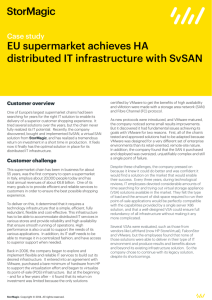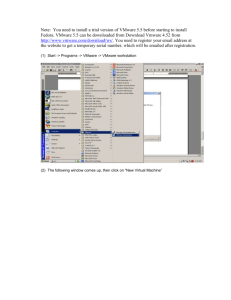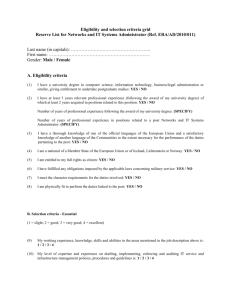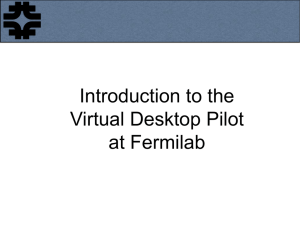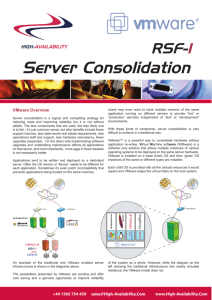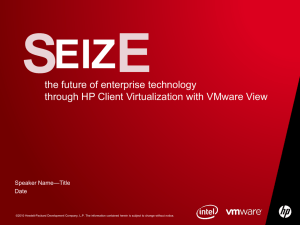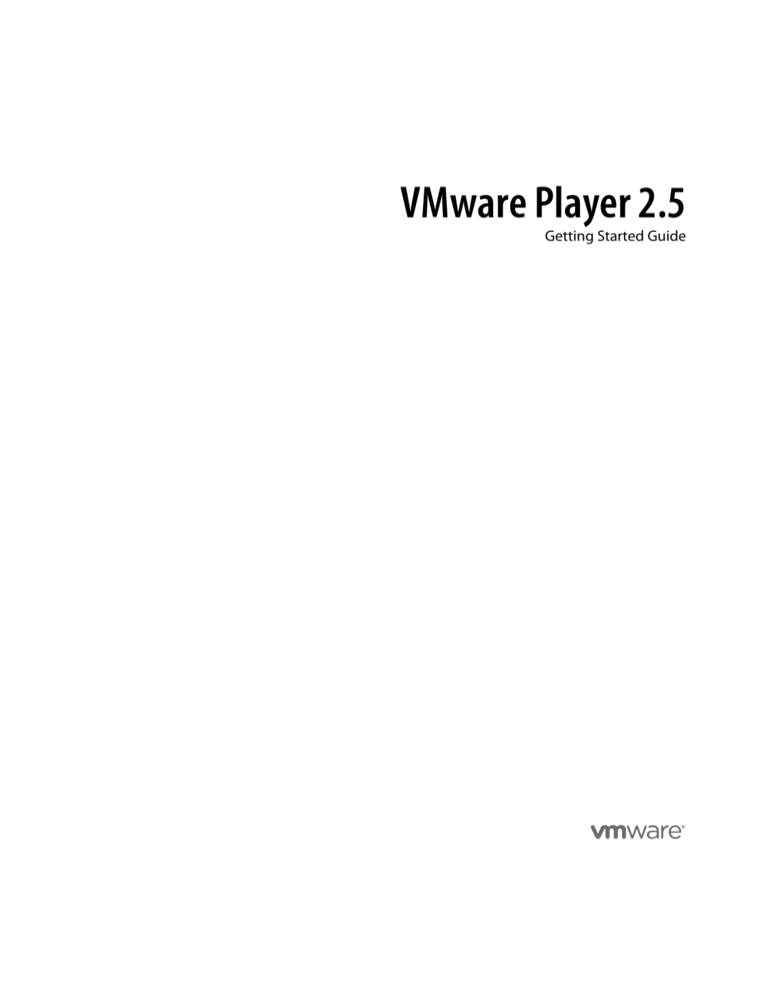
VMware Player 2.5
Getting Started Guide
VMware Player 2.5
VMware Player 2.5
Item: EN-000043-01
You can find the most up-to-date technical documentation on the VMware Web site at:
http://www.vmware.com/support/
The VMware Web site also provides the latest product updates.
If you have comments about this documentation, submit your feedback to:
docfeedback@vmware.com
©
2008 VMware, Inc. All rights reserved. Protected by one or more U.S. Patent Nos. 6,397,242, 6,496,847, 6,704,925, 6,711,672,
6,725,289, 6,735,601, 6,785,886, 6,789,156, 6,795,966, 6,880,022, 6,944,699, 6,961,806, 6,961,941, 7,069,413, 7,082,598, 7,089,377,
7,111,086, 7,111,145, 7,117,481, 7,149,843, 7,155,558, 7,222,221, 7,260,815, 7,260,820, 7,269,683, 7,275,136, 7,277,998, 7,277,999,
7,278,030, 7,281,102, 7,290,253, 7,356,679, 7,409,487, 7,412,492, 7,412,702, 7,424,710, and 7,428,636; patents pending.
VMware, the VMware “boxes” logo and design, Virtual SMP, and VMotion are registered trademarks or trademarks of VMware, Inc.
in the United States and/or other jurisdictions. All other marks and names mentioned herein may be trademarks of their
respective companies.
VMware, Inc.
3401 Hillview Ave.
Palo Alto, CA 94304
www.vmware.com
2
VMware, Inc.
Contents
About This Book
5
Getting Started with VMware Player
7
What Is VMware Player? 7
Installing and Running VMware Player 10
Uninstalling VMware Player 12
Supported Host and Guest Operating Systems for VMware Player
VMware, Inc.
13
3
VMware Player 2.5
4
VMware, Inc.
About This Book
®
This preface provides information about the VMware Player Getting Started Guide and links to VMware
technical support and educational resources.
Intended Audience
This book is intended for anyone who wants to install or use VMware Player 2.5. VMware Player 2.5 users
include anyone who wants to run virtual machines or virtual appliances. You can download and safely run
prebuilt application environments provided by software vendors or colleagues.
Document Feedback
VMware welcomes your suggestions for improving our documentation. If you have comments, send your
feedback to:
docfeedback@vmware.com
Technical Support and Education Resources
The following technical support resources are available to you. To access the current versions of this book and
other books, go to:
http://www.vmware.com/support/pubs
Online and Telephone
Support
Use online support to submit technical support requests, view your product
and contract information, and register your products. Go to:
http://www.vmware.com/support/
Customers with appropriate support contracts should use telephone support
for the fastest response on priority 1 issues. Go to:
http://www.vmware.com/support/phone_support.html.
Support Offerings
Find out how VMware support offerings can help meet your business needs.
Go to: http://www.vmware.com/support/services.
VMware Professional
Services
VMware Education Services courses offer extensive hands-on labs, case study
examples, and course materials designed to be used as on-the-job reference
tools. Courses are available onsite, in the classroom, and live online. For onsite
pilot programs and implementation best practices, VMware Consulting
Services provides offerings to help you assess, plan, build, and manage your
virtual environment. To access information about education classes,
certification programs, and consulting services, go to:
http://www.vmware.com/services/.
VMware, Inc.
5
VMware Player 2.5
6
VMware, Inc.
Getting Started with VMware Player
This chapter includes the following topics:
n
“What Is VMware Player?,” on page 7
n
“Installing and Running VMware Player,” on page 10
n
“Uninstalling VMware Player,” on page 12
n
“Supported Host and Guest Operating Systems for VMware Player,” on page 13
What Is VMware Player?
VMware Player is a free desktop application that lets you perform the following functions:
n
Run virtual machines on a Windows or Linux PC.
n
Run virtual machines without investing in virtualization software, making it easy to take advantage of
the security, flexibility, and portability of virtual machines.
n
Use host machine devices, such as CD and DVD drives, from the virtual machine.
VMware Player provides an intuitive user interface for running preconfigured virtual machines created with
VMware Workstation, ESX Server, VMware Server, VMware Fusion, and GSX Server. On Windows host
machines, you can use VMware Player to open and run Microsoft Virtual PC and Microsoft Virtual Server
virtual machines, and Symantec Backup Exec System Recovery, formerly LiveState Recovery, system images.
VMware Player also lets you download virtual appliances and access Open Virtualization Format (OVF) and
Open Virtual Appliance (OVA) files. For information on VMware Player compatible virtual machines and
system images, see “Compatible Virtual Machines and System Images,” on page 9.
VMware Player makes VMware virtual machines accessible to colleagues, partners, customers, and clients,
whether or not they have purchased VMware products. Anyone who downloads VMware Player can open
and run compatible virtual machines.
NOTE Use of VMware Player is subject to the VMware Player end-user license terms. VMware provides no
support for VMware Player. You can download VMware Player from the VMware Web site.
You can also download virtual appliances to use with VMware Player from the Virtual Appliance Marketplace
from the VMware Web site. For information on installing VMware Player, see “Installing and Running VMware
Player,” on page 10.
For self-help resources, see the VMware Player FAQ under the VMware Desktop Virtualization Products
section of the VMware Web site. You can also participate in the VMware Player Discussion Forum under the
VMware Technology Network (VMTN) section of the VMware Web site. The forum enables VMTN members
to exchange information, questions, and comments regarding VMware products, services, and product support
issues.
VMware, Inc.
7
VMware Player 2.5
What You Can Do with VMware Player
Use and evaluate
prebuilt applications
Download and safely run prebuilt application environments on virtual
machines that are available from the Virtual Appliance Marketplace section on
the VMware Web site. The Virtual Appliance Marketplace includes virtual
machines from leading software vendors, including Oracle, Red Hat, Novell,
BEA, SpikeSource, IBM, and MySQL, as well as virtual machines that are
preconfigured with popular open source software.
Transform software
distribution
Simplify software distribution by shipping preconfigured software on virtual
machines. End users can experience the benefits of your products immediately,
without setup hassles. VMware Player is ideal for shipping evaluation copies
or beta software. You can package complex, sophisticated applications,
complete with a full working environment, on a virtual machine that can be
used by anyone who downloads VMware Player.
Collaborate with
colleagues
VMware Player makes it easy for support, development, and QA to share
customer scenarios in virtual machines.
Features in VMware Player
VMware Player is a free desktop application for running virtual machines. VMware Player does not include
features found in other VMware products, such as Workstation 6.5, which can create virtual machines.
VMware Player provides the following features:
n
Switch to Unity mode to display applications directly on the host desktop.
n
On Linux, the bundle based VMware installer lets you install the product in one step.
n
Both Windows and Linux hosts support suspending the virtual machine when exiting.
n
While in full screen mode, you can switch from one powered-on virtual machine to another.
n
Smart card is supported experimentally.
n
Connect, disconnect, and use configured host devices, including USB devices, in the virtual machine.
n
Set preferences, such as how devices are displayed in VMware Player.
n
Change the amount of memory allocated to the virtual machine.
The following features can be used if VMware Tools is installed on the virtual machine:
n
You can drag and drop files between a Linux or Windows host and a Linux, Windows, or Solaris guest.
Linux hosts and Linux and Solaris guests must be running the X Window System.
n
You can copy and paste text and files between a Windows or Linux host and a Windows, Linux, or Solaris
guest.
NOTE You can open multiple instances of VMware Player. However, each instance of VMware Player can run
only one virtual machine at a time.
For more instructions on using these features, choose VMware Player > Help to view the online help provided
in VMware Player.
8
VMware, Inc.
Getting Started with VMware Player
Host System Requirements for VMware Player
The minimum host system requirements for installing and using VMware Player:
n
Standard x86-compatible or x86-64-compatible PC
n
Processor speed – 733MHz or faster
n
Memory – 512 MB minimum (2GB recommended). You must have enough memory to run the host
operating system, the virtual machine, and applications on the host and guest operating systems.
n
Hard disk – At least 1GB free disk space is recommended for each guest operating system.
For installation, VMware Player requires approximately 250MB (Windows) or 200MB (Linux) free disk space.
You can delete the installer after installation is complete to reclaim disk space.
See “Supported Host and Guest Operating Systems for VMware Player,” on page 13 for additional
information about supported host and guest operating systems.
Compatible Virtual Machines and System Images
The following virtual machines and system images are compatible with VMware Player:
VMware Virtual
Machines
VMware Player runs virtual machines created with VMware Workstation4 and
higher, GSX Server 3.x, VMware Server, and ESX Server 2.5 and higher.
Workstation 4 virtual machines run in legacy mode. Virtual machines created
in versions earlier than Workstation 4 must be upgraded using another
VMware product before you can run them in VMware Player.
Microsoft Virtual PC and
Virtual Server Virtual
Machines
On Windows hosts, VMware Player can run Microsoft Virtual PC and Virtual
Server virtual machines. When you open a Virtual PC virtual machine in
VMware Player, VMware Player creates a VMware-compatible configuration
file (with a .vmx extension), and preserves the original Virtual PC configuration
file (with a .vmc extension). You can save the VMware-compatible virtual
machine without changing your original Virtual PC configuration file.
Symantec Backup Exec
System Recovery
System Images
On Windows hosts, VMware Player can run system images created with
Symantec Backup Exec System Recovery, formerly Symantec LiveState
Recovery. When you open a Backup Exec System Recovery system image in
VMware Player, VMware Player creates a VMware-compatible configuration
file (with a .vmx extension), and preserves the original Backup Exec System
Recovery system image file (with a .sv2i extension). You can save the VMwarecompatible virtual machine without changing your original Virtual PC
configuration file.
Virtual Symmetric Multiprocessing
Virtual Symmetric Multiprocessing (SMP) support in VMware Player is experimental. With this feature, you
can use VMware Player to assign two virtual processors to a virtual machine on any host machine that has at
least two logical processors.
VMware, Inc.
9
VMware Player 2.5
The following are all considered to have two or more logical processors:
n
A multiprocessor host with two or more physical CPUs
n
A single-processor host with a multicore CPU
n
A single-processor host with hyperthreading enabled
NOTE On hyperthreaded uniprocessor hosts, performance of virtual machines with virtual SMP might be
subpar.
Guests with more than two virtual processors are not supported in VMware Player. However, you can power
on and run multiple dual-processor virtual machines concurrently.
Installing and Running VMware Player
The installation instructions for VMware Player are specific to using a product CD to install on Windows and
Linux hosts. If you do not have a product CD, download VMware Player from the VMware Web site.
Install VMware Player on a Windows Host
Prerequisites
If you are installing VMware Player from a CD and autorun is enabled, follow the instructions displayed when
you insert the CD in your CD-ROM drive.
If you are installing VMware Player from a CD and autorun is not enabled, double-click the VMware-player<xxxxx>.exe installer file in the Windows directory of the CD. In the filename, <xxxxx> is a series of numbers
representing the version and build numbers.
If you downloaded the software, follow the installation procedure, but install from the directory where you
saved the installer file (rather than the Windows directory on the CD).
1
On the Welcome page, click Next.
2
(Optional) On the Destination Folder page, choose an alternate location for VMware Player files, and click
Next.
3
(Optional) Deselect any shortcuts on the Configuration Shortcuts page, and click Next.
4
Click Install to begin the installation.
VMware Player and any shortcuts you selected are installed on your host machine.
5
Click Finish.
Install VMware Player on a Linux Host Using a bundle
If you downloaded the software, follow the installation procedure, but install from the directory where you
saved the installer file (rather than the Linux directory on the CD).
NOTE If you do not enable host-only networking when you install VMware Player, you cannot allow a virtual
machine to use both bridged and host-only networking.
1
Log on to your Linux host with the user name you plan to use when running VMware Player.
2
In a terminal window, become root to perform the initial installation steps:
su
10
VMware, Inc.
Getting Started with VMware Player
3
If you are installing from a downloaded file, mount the VMware Player CD-ROM:
u
VMware-Player-e.x.p-<xxxx-xxxx>.i386.bundle
or
u
VMware-Player-e.x.p-<xxxx-xxxx>.x86_64.bundle
VMware-Player-e.x.p-<xxxxx>.<architecture>.bundle is the installation file. In the filename, <xxxx-xxxx>
is a series of numbers representing the version and build numbers.
4
Run bundle specifying the installation file:
sh VMware-Player-e.x.p-<xxxx-xxxx>.<architecture>.bundle
5
Accept the EULA to continue.
6
Open VMware Player from your Desktop Program menu or run vmplayer in a terminal to launch the kernel
module updater to install and configure the kernel.
Using Command-Line Installation Options
You can also use command-line installation options to install Workstation on a Linux host.
To use the options you must be logged in as root. After finishing the installation process exit from the root
account.
If the GUI based VMware Player installer fails, run the installation file with the --console command in your
terminal. The common command-line installation options are the following:
--gtk
Opens the GUI based VMware installer which is the default option.
--regular
Shows the optional steps for installation such as the directory path for the
Integrated Virtual Debugger for Eclipse. This is the default option.
--console
Lets you use the terminal for installation.
--custom
Shows all the directory paths for the binary files, library files, manual files,
documentation files, and init script during installation.
--required
Opens only the EULA and proceeds to install VMware Player.
--ignore-errors
Uninstalls the files and ignores configuration errors during uninstall.
Install VMware Player on a Linux Host Using an RPM
If you downloaded the software, follow the installation procedure, but install from the directory where you
saved the installer file (rather than the Linux directory on the CD).
NOTE If you do not enable host-only networking when you install VMware Player, you cannot allow a virtual
machine to use both bridged and host-only networking.
1
Log on to your Linux host with the user name you plan to use when running VMware Player.
2
In a terminal window, become root to perform the initial installation steps:
su
3
Run RPM specifying the installation file:
rpm -Uhv VMware-<xxxx>.rpm
VMware-<xxxx>.rpm is the installation file. In the filename, <xxxxx> is a series of numbers representing the
version and build numbers.
VMware, Inc.
11
VMware Player 2.5
4
Run the configuration program from the command line:
vmware-config.pl
5
At the prompts, accept the default values.
The configuration program displays a message saying the configuration completed successfully. If you
do not see the configuration completion message, run the configuration program again.
6
When you are done, exit from the root account:
exit
Start VMware Player
1
To open your VMware Player:
Choose VMware Player from the Start > Programs menu in Windows or from the corresponding program
menu in a Linux X windows session.
2
n
On Windows, type vmplayer from the Start > Run command menu. You can also type <path>
\vmplayer.exe in the command interpreter, where <path> is the appropriate path on your system to
the VMware Player executable file.
n
From the Linux command line, type <path>/vmplayer, where <path> is the appropriate path on your
system to the VMware Player executable file. If you want to run VMware Player in the background,
type <path>/vmplayer &.
Browse for the configuration file of the virtual machine that you want to run.
You can also select a recently used virtual machine or download a virtual appliance from the Virtual
Appliance Marketplace.
You can use the field Files of type to filter the files that are displayed when you browse.
VMware Player can open .vmx VMware configuration files, OVF, and OVA files. On Windows, VMware
Player can open .vmc Microsoft Virtual PC and Virtual Server files and .sv2i Symantec Backup Exec
System Recovery system images.
3
Select a virtual machine configuration file, and click Open.
You can also open a virtual machine by right-clicking its configuration file to display a context menu from
which you can open the virtual machine in VMware Player.
Close VMware Player
u
Do one of the following:
a
Shut down the guest operating system in the virtual machine.
VMware Player closes after the guest operating system shuts down.
b
Choose VMware Player > Exit (Windows) or VMware Player > Quit (Linux).
VMware Player either suspends or powers off the virtual machine, depending on the preference you
have set for exit behavior in VMware Player > Preferences.
Uninstalling VMware Player
The following sections describe how to uninstall VMware Player on Windows and Linux hosts.
12
VMware, Inc.
Getting Started with VMware Player
Uninstall VMware Player on a Windows Host other than Vista
1
In the Control Panel, open Add/Remove Programs.
2
Select the entry for VMware Player and click Remove.
3
Follow the on-screen instructions.
Uninstall VMware Player on a Windows Vista Host
1
Go to Start > Control Panel > Programs > Programs and Features > Uninstall a program.
2
Select VMware Player and click Uninstall.
Uninstall a bundle Installation of VMware Player on a Linux Host
u
Enter the following command to remove VMware Player from your system:
vmware-uninstall
Uninstall an RPM Installation of VMware Player on a Linux Host
1
Find the VMware Player build number by entering the following command:
rpm -qa | grep VM
2
Remove the software from your system by entering the following command, where <xxxx-xxxx> is a series
of numbers that represent the version and build:
rpm -e VMware<xxxx-xxxx>
Supported Host and Guest Operating Systems for VMware Player
The terms host and guest describe your physical and virtual machines.
Host
The physical computer on which you install the VMware Player software is
called the host machine, and its operating system is called the host operating
system.
Guest
The operating system running inside a virtual machine is called a guest
operating system.
Supported Host Operating Systems
VMware Player is available for both Windows and Linux host operating systems.
Windows Host Operating Systems
VMware Player supports the following Windows 32-bit and 64-bit host operating systems.
VMware, Inc.
13
VMware Player 2.5
Table 1. Windows Host Operating Systems
Processor Type
Operating System Edition
32-bit
Windows Vista Enterprise Edition, SP1
Windows Vista Business Edition, SP1
Windows Vista Home Basic and Premium Editions, SP1
Windows Vista Ultimate Edition, SP1, SP3
Listed versions are also supported with no service pack.
Windows Server 2003 Standard Edition with SP1
Windows Server 2003 Web Edition with SP1
Windows Server 2003 Small Business Edition with SP1
Windows Server 2003 Enterprise Edition with SP1
Windows Server 2003 R2, SP2
Windows XP Home Edition with SP2 or later service pack
Windows XP Professional with SP2 or later service pack
Windows 2000 Server with SP4
Windows 2000 Professional with SP4
Windows 2000 Advanced Server with SP4
64-bit
Windows Vista Enterprise Edition, SP1
Windows Vista Business Edition, SP1
Windows Vista Home Basic and Premium Editions, SP1
Windows Vista Ultimate Edition, SP1
Listed versions are also supported with no service pack.
Windows Server 2003 x64 Edition with SP1
Windows Server 2003 x64 Edition R2 SP2
Windows XP Professional x64 Edition with SP1 or later service pack
Linux Host Operating Systems
VMware Player supports the following Linux 32-bit and 64-bit distributions and kernels for the host operating
systems. VMware Player might not run on systems that do not meet these requirements.
As newer Linux kernels and distributions are released, VMware modifies and tests its products for stability
and reliability on those host platforms. VMware makes every effort to add support for new kernels and
distributions in a timely manner, but until a kernel or distribution is added to the list below, its use with
VMware products is not supported. Look for newer prebuilt modules in the download area of the VMware
Web site.
Table 2. Linux Host Operating Systems
Processor Type
Operating System Edition
32-bit
Asianux Server 3
CentOS 5.2
CentOS 5.1
CentOS 5.0
Mandriva Corporate Desktop 4.0
Mandriva Corporate Server 4.0
Oracle Enterprise Linux 5.2
Oracle Enterprise Linux 5.1
Oracle Enterprise Linux 5.0
14
VMware, Inc.
Getting Started with VMware Player
Table 2. Linux Host Operating Systems (Continued)
Processor Type
Operating System Edition
Red Hat Enterprise Linux 5.2 WS
Red Hat Enterprise Linux 5.2 AS, ES
Red Hat Enterprise Linux 5.1 WS
Red Hat Enterprise Linux 5.1 AS, ES
Red Hat Enterprise Linux 5.0
Red Hat Enterprise Linux 4.7
Red Hat Enterprise Linux 4.6
Red Hat Enterprise Linux WS 4.5 (formerly called 4.0 Update 5)
Red Hat Enterprise Linux AS 4.0, updates 1, 2, 3, 4
Red Hat Enterprise Linux ES 4.0, updates 1, 2, 3, 4
Red Hat Enterprise Linux WS 4.0, updates 1, 2, 3, 4
SUSE Linux Enterprise Server 10 SP1
SUSE Linux Enterprise Server 9, SP1, SP2, SP3, SP4
SUSE Linux Enterprise Desktop 10, SP1, SP2
Listed versions are also supported with no service pack.
openSUSE 10.3 (experimental)
openSUSE 10.2 (formerly known as SUSE Linux 10.2)
Ubuntu Linux 8.04
Ubuntu Linux 7.10
Ubuntu Linux 7.04
Ubuntu Linux 6.10
Ubuntu Linux 6.06
64-bit
Asianux Server 3
CentOS 5.2
CentOS 5.1
CentOS 5.0
Mandriva Corporate Desktop 4.0
Mandriva Corporate Server 4.0
Note: On 64-bit Mandriva hosts, some 32-bit compatibility libraries are required.
Specifically, 32-bit glibc, X11, and libXtst.so are required.
Oracle Enterprise Linux 5.2
Oracle Enterprise Linux 5.1
Oracle Enterprise Linux 5.0
Red Hat Enterprise Linux 5.2 WS
Red Hat Enterprise Linux 5.2 AS, ES
Red Hat Enterprise Linux 5.1 WS
Red Hat Enterprise Linux 5.1 AS, ES
Red Hat Enterprise Linux 5.0
Red Hat Enterprise Linux 4.7
Red Hat Enterprise Linux 4.6
Red Hat Enterprise Linux 4.5 (formerly called 4.0 Update 5)
Red Hat Enterprise Linux AS 4.0, updates 3, 4
Red Hat Enterprise Linux ES 4.0, updates 3, 4
Red Hat Enterprise Linux WS 4.0, updates 3, 4
Red Hat Enterprise Linux AS 3.0, stock 2.4.21, updates 2.4.21-15, 6, 7, 8
Red Hat Enterprise Linux ES 3.0, stock 2.4.21, updates 2.4.21-15, 6, 7, 8
Red Hat Enterprise Linux WS 3.0, stock 2.4.21, updates 2.4.21-15, 6, 7, 8
VMware, Inc.
15
VMware Player 2.5
Table 2. Linux Host Operating Systems (Continued)
Processor Type
Operating System Edition
SUSE Linux Enterprise Server 10, SP1
SUSE Linux Enterprise Server 9, SP1, SP2, SP3, SP4
SUSE Linux Enterprise Desktop 10, SP1, SP2
Listed versions are also supported with no service pack.
openSUSE 10.3
openSUSE 10.2 (formerly known as SUSE Linux 10.2)
Ubuntu Linux 8.04
Ubuntu Linux 7.10
Ubuntu Linux 7.04
Ubuntu Linux 6.10
Ubuntu Linux 6.06
Note: On 64-bit Ubuntu 6.x hosts, some 32-bit compatibility libraries are required.
Specifically, 32-bit glibc and X11 are required.
Supported Guest Operating Systems
VMware continually adds support for new guest operating systems and new versions and updates of currently
supported operating systems. For the most recent list of supported guest operating systems, including detailed
information about the specific operating system versions, service packs, and updates supported, see the
VMware Guest Operating System Installation Guideunder the Documentation section of the VMware Web site.
This guide also provides notes on installing the most common guest operating systems. VMware Player is not
listed in the VMware Guest Operating System Installation Guide, but the information for VMware Workstation
6.5 is applicable to VMware Player 2.5. Operating systems that are not listed are not supported for use in a
virtual machine.
Table 3. Guest Operating Systems
Processor Type
Operating System Edition
Windows 32-bit
Windows Vista Home Basic and Premium
Windows Vista Business
Windows Vista Enterprise
Windows Vista Ultimate
(Aero and 3-D effects not yet supported)
Windows Server 2008 Standard Edition without Hyper-V
Windows Server 2008 Datacenter Edition without Hyper-V
Windows Server 2008 Enterprise Edition without Hyper-V
(Aero and 3-D effects not yet supported)
Windows Server 2003 Standard Edition
Windows Server 2003 Small Business Edition
Windows Server 2003 Web Edition
Windows XP Professional
Windows XP Home Edition
Windows PE
Windows RE
Windows 2000 Professional
Windows 2000 Server
Windows 2000 Advanced Server
16
VMware, Inc.
Getting Started with VMware Player
Table 3. Guest Operating Systems (Continued)
Processor Type
Operating System Edition
Windows NT 4.0 Workstation with SP6
Windows NT 4.0 Server with SP6
Windows NT 4.0 Terminal Server Edition with SP6
Windows Me
Windows 95
Windows for Workgroups
Windows 64-bit
Windows Vista Home Basic and Premium
Windows Vista Business
Windows Vista Enterprise
Windows Vista Ultimate
(Aero and 3-D effects not yet supported)
Windows Server 2008 x64 Standard Ed. without Hyper-V
Windows Server 2008 Datacenter x64 Ed. without Hyper-V
Windows Server 2008 Enterprise x64 Ed. without Hyper-V
(Aero and 3-D effects not yet supported)
Windows Server 2003 x64
Windows Server x64
Windows XP Professional x64
Windows PE x64
Windows RE x64
Linux 32-bit
Asianux Server
CentOS
Mandrake Linux
Mandriva Linux
Mandriva Corporate Desktop
Mandriva Corporate Server
Novell Linux Desktop
Oracle Enterprise Linux
Red Hat Linux
Red Hat Enterprise Linux
Red Hat Enterprise Linux Advanced Server (AS)
Red Hat Enterprise Linux Enterprise Server (ES)
Red Hat Enterprise Linux Workstation
Red Hat Enterprise Linux Desktop with or without the Workstation Option
Red Hat Enterprise Linux Advanced Platform with or without the Workstation
Option
SUSE Linux
openSUSE Linux
SUSE Linux Enterprise Server
SUSE Linux Enterprise Desktop
Turbolinux Server
Turbolinux Enterprise Server
Turbolinux Workstation
Turbolinux Desktop
Ubuntu Linux
VMware, Inc.
17
VMware Player 2.5
Table 3. Guest Operating Systems (Continued)
Processor Type
Operating System Edition
Linux 64-bit
Asianux Server
CentOS
Mandriva Linux
Mandriva Corporate Desktop
Mandriva Corporate Server
Oracle Enterprise Linux
Red Hat Enterprise Linux
Red Hat Enterprise Linux Advanced Server (AS)
Red Hat Enterprise Linux Enterprise Server (ES)
Red Hat Enterprise Linux Workstation
Red Hat Enterprise Linux Desktop with or without the Workstation Option
Red Hat Enterprise Linux Advanced Platform with or without the Workstation
Option
SUSE Linux
openSUSE Linux
SUSE Linux Enterprise Server
SUSE Linux Enterprise Desktop
Turbolinux Server
Ubuntu Linux
Novell NetWare 32-Bit
NetWare
Novell Open Enterprise Server 32-bit
Open Enterprise Server 32-bit
FreeBSD 32-bit
FreeBSD 32-bit
NOTE If you use SCSI virtual disks larger than 2GB with FreeBSD 4.0–4.3, the
guest operating system does not boot. To work around this issue, see the
VMware Guest Operating System Installation Guide.
FreeBSD 64-bit
FreeBSD 64-bit
Sun 32-bit
Solaris x86 32-bit
Sun Java Desktop System (JDS)
Sun 64-bit
Solaris x86 64-bit
Microsoft MS-DOS
MS-DOS
Processor Support for 64-Bit Guest Operating Systems
VMware Player supports virtual machines with 64-bit guest operating systems, running on host machines with
the following processors:
n
Revision D or later of AMD Athlon 64, Opteron, Turion 64, and Sempron
n
Intel Pentium 4 and Core 2 processors with EM64T and Intel Virtualization Technology
VMware Player supports virtual machines with 64-bit guest operating systems on host machines that have one
of the supported 64-bit processors. When you power on a virtual machine with a 64-bit guest operating system,
VMware Player performs an internal check. If the host CPU is not a supported 64-bit processor, you cannot
power on the virtual machine.
VMware also provides a standalone utility that you can use without VMware Player to perform the same check
and determine whether your CPU is supported for VMware Player virtual machines with 64-bit guest operating
systems. Download the 64-bit processor check utility from the downloads area of the VMware Web site.
18
VMware, Inc.


